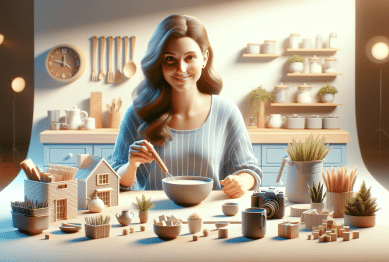Explore how minimalist living can turn any home into a relaxing sanctuary with simple shifts in design and mindset. This in-depth guide covers decluttering, mindful decor, and practical routines for those seeking simplicity and harmony in their daily surroundings.
Understanding the Minimalist Lifestyle
Minimalism is more than a design trend—it’s a lifestyle that focuses on simplifying both physical spaces and mental routines. Many people are drawn to minimalist living because it can reduce stress, promote clarity, and create an environment where only what truly matters remains in focus. Removing clutter and narrowing priorities can have a profound effect, helping individuals reclaim both their space and their time. Embracing minimalist lifestyle ideas doesn’t necessarily mean living with bare walls or empty shelves. Instead, it encourages intentional choices in what you own and cherish.
The movement toward minimalist living ideas has increased as people confront the overwhelm of busy schedules, overflowing closets, and constant digital noise. Studies suggest that excessive belongings and visual clutter can raise anxiety and distract from meaningful activities (Source: https://www.apa.org/monitor/2019/01/ce-corner-decluttering). Shifting to a minimalist mindset means valuing quality over quantity, integrating functional decor, and setting boundaries around consumption. Gradually, this leads to homes filled with useful, beautiful objects that spark joy and calm.
Choosing a minimalist lifestyle starts with small decisions. Whether focusing on wardrobe choices or curating bookshelves, each step strengthens the ability to be selective and mindful. Many minimalist enthusiasts highlight that less really can be more: with fewer things, comes more space to breathe, think, and enjoy. The minimalist journey is unique for every household, adapting to specific needs while consistently reducing life’s excess pressure.
Decluttering Strategies for Every Home
Tackling clutter can be an overwhelming process, but effective strategies make it manageable. A proven method is to sort items by category rather than by room—clothing, books, kitchen gadgets—providing clarity and momentum. Setting aside scheduled ‘declutter sessions’ helps avoid fatigue. Consider the ‘one in, one out’ rule: for every new item brought into the home, something else finds a new purpose or owner. This slow and steady method can turn daunting piles into peaceful order.
Many people face sentimental roadblocks when downsizing possessions. While it’s important to honor memories, the minimalist living philosophy encourages separating emotional value from physical objects. Items can be photographed or digitized to preserve memory, allowing the physical space to remain serene (Source: https://www.npr.org/sections/health-shots/2022/07/09/1109595122/declutter-mental-health). Community donation centers, online marketplaces, and upcycling ideas also help ensure that unwanted things go on to serve new purposes elsewhere.
Decluttering isn’t a one-time event—it’s an ongoing habit that supports a more minimalist home in the long run. Creating an organized environment offers mental relief and saves time day to day. Simple adjustments like a designated donation bin, digital reminders for seasonal purges, and household declutter challenges can reinforce the minimalist approach and keep your home streamlined throughout the year.
Minimalist Decor and Functional Design
Decorating a minimalist home combines function and beauty. The focus is on multi-purpose pieces, clean lines, and neutral palettes. Minimalist decor favors furniture that serves several uses—such as storage benches or modular shelving—which reduces crowded spaces. Texture, natural materials, and strategically placed lighting create warmth while upholding simplicity. A minimalist approach doesn’t require abandoning style. In fact, curated details stand out more when surrounded by open space and thoughtful arrangements.
Color plays a subtle yet significant role in minimalist decor. Soft whites, earthy neutrals, and occasional muted tones produce calm and continuity. Selecting a statement artwork or handcrafted vase allows for personal flair without visual chaos. Plants—real or faux—offer organic beauty, improve indoor air quality, and pair seamlessly with a minimalist design strategy (Source: https://extension.psu.edu/human-health-in-the-built-environment). When every item has a purpose, the result is a space that feels larger, lighter, and more harmonious.
Minimalism extends to storage solutions. Open shelving, concealed bins, and vertical storage maintain order without sacrificing style. By rotating art, seasonal linens, or favored mementos, you continually refresh the environment while preventing overcrowding. The core principle: intentional curation. Through careful choices and regular evaluation, your home remains restful, not rigid—welcoming, not sterile.
Mindful Routines and Habits That Support Simplicity
Minimalism isn’t just about possessions—it’s a mindset. Establishing mindful routines brings lasting calm, whether starting the day with meditation, spending five minutes tidying, or tracking daily priorities in a simple journal. Research indicates that intentional living reduces stress, encourages self-reflection, and improves mental focus (Source: https://www.nimh.nih.gov/health/topics/caring-for-your-mental-health). By scheduling quiet breaks or digital detox hours, distractions lessen and inner space expands. These rituals can be as individual as you are.
Routines extend beyond morning coffee and evening wind-downs. Minimalist living advocates regular self-assessment—what’s necessary, what’s meaningful, and what can go. Setting boundaries with screens and notifications can be challenging but rewarding. Families may discover that eating together without digital interruptions revives connection. Each simple habit compounds over time, leading to greater satisfaction and less stress in modern life.
Even the busiest schedules can accommodate micro-moments of mindfulness. A daily walk, a moment to admire a sunrise, or an uncluttered workspace can boost mood and productivity. By embracing both physical and mental minimalism, individuals create more space for passion projects, restful evenings, and meaningful relationships. Daily rituals reinforce the art of living with intention and clarity.
Sustainable Minimalism and Community Impact
Minimalist living naturally aligns with sustainability goals. Purchasing less, choosing durable goods, and repurposing items all reduce environmental footprint. Conscious consumption looks beyond trends—favoring products that last and materials that are earth-friendly. Swaps like reusable containers, quality textiles, and energy-efficient appliances contribute to resource conservation (Source: https://www.epa.gov/recycle/reducing-waste-what-you-can-do). Minimalism isn’t only a personal journey; it’s a movement towards a more responsible society.
Community involvement enhances the value of a minimalist lifestyle. Neighborhood swaps, repair cafes, and sharing libraries encourage re-use and collective ownership, actively strengthening community bonds (Source: https://shareable.net/). Reducing consumption together multiplies impact, diverts household waste, and introduces creative alternatives to buying new. Minimalist principles can even spark local initiatives for better recycling or upcycling programs, benefiting everyone.
Living minimally opens more time and energy for experiences, learning, and meaningful connections. Whether volunteering or hosting group declutter days, the ripple effect often spreads inspiration. Ultimately, sustainable minimalism fosters a lifestyle that values both people and planet—cultivating joy and purpose beyond material accumulation.
Minimalist Living: Challenges and Lifelong Benefits
Transitioning to a minimalist lifestyle isn’t always straightforward. Emotional attachment to belongings, social expectations, or fear of missing out can slow progress. Yet, each challenge presents an opportunity to reassess values and reflect on what brings lasting fulfillment. Over time, the clarity and order achieved make the initial discomfort worthwhile. Many report that the journey sparks deeper self-knowledge and strengthens intention in all life areas.
Benefits of minimalist living go well beyond a tidy house. Studies associate minimalist habits with better focus, reduced anxiety, improved relationships, and greater overall contentment (Source: https://greatergood.berkeley.edu/article/item/how_minimalism_can_help_reduce_stress). Letting go of unnecessary obligations and commitments frees you to pursue priorities and explore passions. The adaptability of minimalism means anyone can personalize it—whether through home organization, digital decluttering, or simplified routines.
The minimalist mindset endures long after the physical transformation. Life’s inevitable changes—moving, growing families, evolving tastes—are met with greater flexibility and confidence. Continuous self-assessment, gratitude, and mindful choices pave the way for a future centered around meaning and well-being, leaving space for growth rather than clutter.
References
1. American Psychological Association. (2019). Decluttering and Mental Health. Retrieved from https://www.apa.org/monitor/2019/01/ce-corner-decluttering
2. NPR. (2022). How Decluttering Your Space Might Help Your Mental Health. Retrieved from https://www.npr.org/sections/health-shots/2022/07/09/1109595122/declutter-mental-health
3. Penn State Extension. (n.d.). Human Health in the Built Environment. Retrieved from https://extension.psu.edu/human-health-in-the-built-environment
4. National Institute of Mental Health. (n.d.). Caring for Your Mental Health. Retrieved from https://www.nimh.nih.gov/health/topics/caring-for-your-mental-health
5. U.S. Environmental Protection Agency. (n.d.). Reducing Waste: What You Can Do. Retrieved from https://www.epa.gov/recycle/reducing-waste-what-you-can-do
6. Greater Good Science Center, UC Berkeley. (n.d.). How Minimalism Can Help Reduce Stress. Retrieved from https://greatergood.berkeley.edu/article/item/how_minimalism_can_help_reduce_stress









